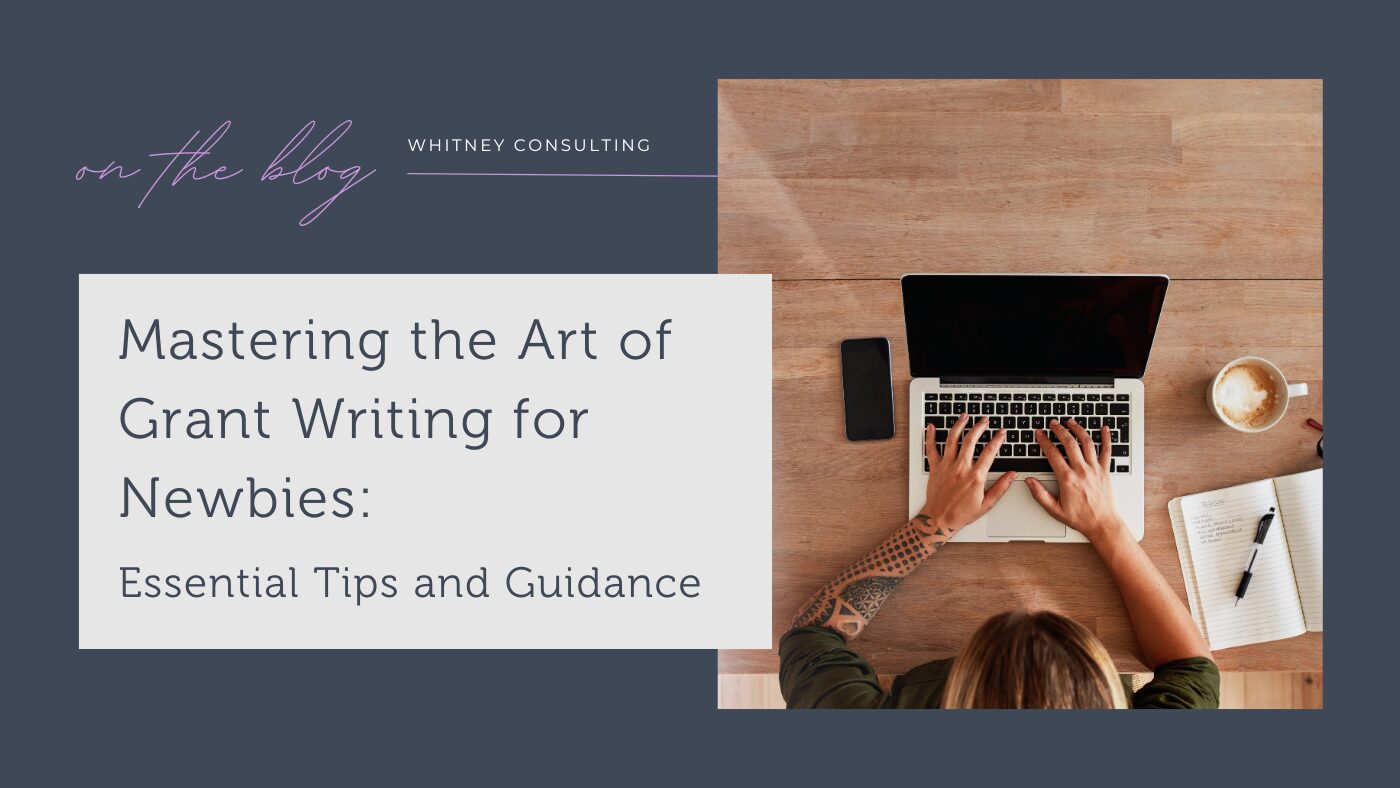Are you a newbie looking to break into the world of grant writing? Whether you’re a budding professional grant writer or someone tasked with finding funding for your business, a local government or a non-profit organisation, mastering this skill can open the door to significant funding opportunities. Understanding how to craft compelling, strategic proposals is key to obtaining grants from government agencies and private funders alike.
To start, you need to familiarise yourself with the basics of grant writing. This involves setting clear goals, understanding the needs of your project, and clearly communicating those needs to potential funders. Learning how to create a persuasive narrative is crucial to help your proposal stand out. With a solid approach, even beginners can find success in the competitive realm of grant acquisition.
Your journey to mastering grant writing doesn’t have to be daunting. Numerous resources, such as workshops and online courses, can provide practical insights and step-by-step guidance. Developing these skills ensures you can effectively articulate your project’s value, meet the specific requirements of different funders, and ultimately secure the financial support your organisation needs.
Understanding the Grant Landscape
Knowing the grant landscape means recognising different funding sources and understanding their specific criteria and priorities. This insight can help you better target your proposals.
Evaluating Funding Sources
To start, research various funding sources. These can include government agencies, private foundations, and corporate giving programs. Each has unique missions and objectives. Identify those that align with your project’s aims.
Government agencies often have publicly available grant directories. Private foundations might require digging into their annual reports or websites. Corporations often support initiatives that resonate with their business goals. Create a table listing potential funders, their interests, and deadlines.
Deciphering Eligibility and Funding Priorities
Understanding eligibility criteria is crucial. Each funder will have specific requirements. These might relate to organisation type, project scope, or geographical focus. Review these criteria closely to avoid wasted effort on ineligible proposals.
Next, look at funding priorities. These are the areas funders want to support. Check past grant recipients to understand these better. Some funders prioritise health, while others focus on education or community projects. Use this knowledge to tailor your proposal, highlighting how your project aligns with their goals.
Preparing for Your Grant Application
Before starting your grant application, you need to focus on demonstrating your organisation’s credibility, creating a detailed project plan, and highlighting any collaborative efforts or partnerships that will strengthen your proposal.
Establishing Organisational Credibility
Your grant application needs to reflect the strength and legitimacy of your organisation. Start by showcasing your organisation’s history, achievements, and expertise. Include details about past projects and their outcomes.
Provide specific data and testimonials to support your claims. Mention any certifications, awards, or recognitions your organisation has received. If applicable, include information about your staff’s qualifications and experience.
Creating a narrative that highlights your organisation’s reliability and effectiveness can make a significant difference. Funders want to invest in organisations that have proven they can deliver results.
Developing a Compelling Project Plan
A well-structured project plan is critical. Begin with a clear and concise statement of your project’s goals and objectives. Use specific language to describe what you aim to achieve and why it is important.
Detail the timeline of your project, breaking it down into phases or milestones. Describe the activities you will undertake in each phase and what resources will be needed.
Explain your budget in clear terms. Include estimated costs for personnel, equipment, and other resources. Justify each expense to show how it contributes to the project’s success. Make sure your plan illustrates the feasibility and impact of your project.
Collaboration and Partnerships
Emphasising collaboration and partnerships can strengthen your proposal. Describe any partnerships you have established or plan to establish. Explain the role each partner will play and how they will contribute to the project’s success.
Detail any previous successful collaborations to show your capability to work effectively with others. Explain how these partnerships will enhance your project and provide added value.
Including letters of support from partners can also be beneficial. These letters should outline their commitment and the specific support they will provide, helping to reinforce the credibility and impact of your project.
Approaching your grant application with thorough preparation can significantly enhance your chances of success.
Crafting a Persuasive Grant Proposal
Creating a persuasive grant proposal involves clearly articulating how your project outcomes meet the funder’s goals, presenting a compelling narrative, and ensuring meticulous budgeting and financial projections.
Articulating Your Project Outcomes
Start by defining the problem your project will address. You should clarify what your project aims to achieve and why it is important. Then articulate the solution – paint a picture of the future you seek to create through this project. Use clear, concise language to make these elements stand out.
Providing specific goals and objectives helps funders understand the impact of your work. Aligning your project’s outcomes clearly with the funder’s objectives is the only way you are likely to receive support.
Presenting a Clear Narrative
A compelling narrative is crucial to capturing the funder’s interest. Begin with a strong introduction that outlines the problem or need your project addresses. Use real-life examples and data to illustrate the urgency and importance.
If possible, break your narrative into clear sections: Background, Objectives, Approach, and Expected Outcomes. Each section should logically flow from the previous one, building a coherent story. Highlighting previous successes or testimonials can bolster your proposal.
Budgeting and Financial Projections
Accuracy in budgeting and financial projections demonstrates transparency and credibility. Detail each expense and justify its necessity. Include line items for staff, materials, equipment, and indirect costs.
If allowed, provide a budget table for clarity. This should outline each category, estimated cost, and total amount requested. Funders appreciate transparency and solid financial planning, so explain how funds will be managed and accounted for to maximise impact.
Include potential sources of additional support if applicable. This reassures funders about the project’s sustainability. A clear budget increases the trust funders have in your ability to deliver results.
Essential Writing and Submission Techniques
To master grant writing, you need to focus on acquiring core skills, understanding submission guidelines, and revising your proposals meticulously. Each step requires attention and precision for a successful grant application.
Employing Core Grant Writing Skills
Start by honing your writing skills. Your proposal should be clear, concise, and compelling. Use simple, direct language and avoid jargon. Every sentence should add value and reinforce your main points.
Know your audience. Tailor your language and content to fit the interests and priorities of the funding organisation. Highlight how your project aligns with their goals.
Structure is essential. Use headings, subheadings, and bullet points (if allowed) to organise information. Ensure each section flows logically into the next. A well-structured proposal makes it easier for reviewers to follow your argument and understand your project’s potential impact.
Understanding Submission Guidelines
Before writing, thoroughly read the submission guidelines. Each grant has specific requirements regarding format, length, and content. Not following these can disqualify your application.
Create a checklist based on the guidelines. This might include required documents, deadlines, and formatting rules. Ensure every item is ready and compliant.
Pay attention to technical details. This includes font size, spacing, and margin settings. Avoid mistakes that are very common in grant writing. Small mistakes can reflect poorly on your attention to detail.
Revising and Refining Your Submission
Drafting is just the beginning. Revision is where your proposal truly comes to life. Review your draft multiple times. Look for clarity, coherence, and persuasiveness.
Seek feedback from colleagues or mentors. Fresh eyes can spot weaknesses or errors you may have overlooked. Use their input to strengthen your proposal.
Proofread meticulously. Errors and typos can undermine your credibility. Also, check that all required elements are included and correctly formatted. A polished submission reflects your professionalism and dedication.
By focusing on these techniques, you will significantly improve your chances of securing funding for your project.
Maximising Impact and Securing Funding
To secure grant funding, you need to demonstrate the real impact of your project and maintain effective communication with funders. By focusing on these aspects, you can improve your chances of receiving the grants you seek.
Demonstrating Impact and Improvement
Show how your project makes a difference. Document your progress with before-and-after data. Use surveys and case studies to highlight your success stories. For instance, if your project aimed to increase literacy rates, present statistics showing the improvement.
Clearly define your project goals and outcomes. Funders want to see tangible results, and explaining how you get there is vital. Include specific examples and metrics. Use charts and graphs for clarity. Testimonials from beneficiaries can add a human touch.
Feedback loops are essential. Collect constructive feedback regularly to fine-tune your project. Show funders that you are committed to continuous improvement. Include examples of changes made based on feedback to highlight adaptability and growth.
Effective Communication and Follow-Up
Clear communication with funders is crucial. Start with a well-written proposal that lays out your vision, methods, and expected impacts. Avoid jargon and keep your language accessible. This helps funders quickly understand your project’s value.
Maintain regular updates with funders. Send progress reports that are concise and informative. Highlight milestones achieved and any challenges faced. Honesty about setbacks, combined with a plan to address them, builds trust.
Follow up after submitting your proposal. A polite query can show your enthusiasm and commitment. Also, after receiving feedback – whether positive or negative – respond constructively. Thank funders for their time and use their feedback to improve future proposals.
Your ability to communicate well and follow up shows funders that you are organised and dedicated. This can greatly increase your chances of securing funding.
Frequently Asked Questions
This section provides answers to common queries about grant writing, focusing on proposal components, researching funders, project feasibility, conveying significance, maintaining narrative, and budget planning.
What essential components should a grant proposal have?
A strong grant proposal includes a clear problem statement, specific goals, and objectives. You should also include a detailed project description, a budget, and a timeline. Address any potential risks and include an evaluation plan.
How can one effectively research potential funders?
Look for funders whose goals align with your project. Use resources like online databases, funding directories, and networking events. Review the funders’ past grantees and criteria to ensure a good match.
In what ways can you demonstrate project feasibility within a grant application?
Detail your project plan with clear steps and timelines. Include qualifications and experience of your team members. Provide evidence of past success in similar projects. Highlight any partnerships or community support.
What strategies are key to effectively conveying the significance of a project?
Use data and statistics to support your claims. Tell a compelling story that connects with the funder’s mission. Highlight the potential impact and any unique aspects of your project. Explain the long-term benefits and sustainability.
How can an individual maintain a strong narrative throughout the grant proposal?
Keep your writing concise and focused. Ensure each section flows logically into the next. Use consistent language and tone. Reinforce your key points throughout the proposal. Include real-world examples and success stories.
What are the best practices for budget planning in grant applications?
Be detailed and realistic in your budget. Include all necessary expenses and justify each cost. Use clear categories for different expenses. Provide quotes if possible. Ensure your budget aligns with your project goals and timeline.
Your Grant Writing Journey Begins Here: Write, Revise, Succeed!
Are you ready to turn your grant application into a winning proposal?
Navigating the complex world of grants can be daunting, especially for newcomers. But with the right guidance, you can master the art of grant writing and unlock funding opportunities for your projects. Whitney Consulting offers the expertise you need, led by certified grant writers who understand the nuances of successful applications. Whether you’re seeking government grants or private funding, our team is here to help you every step of the way. Don’t leave your funding to chance—reach out to us and partner with Whitney Consulting and transform your ideas into reality with a professionally crafted grant proposal.






